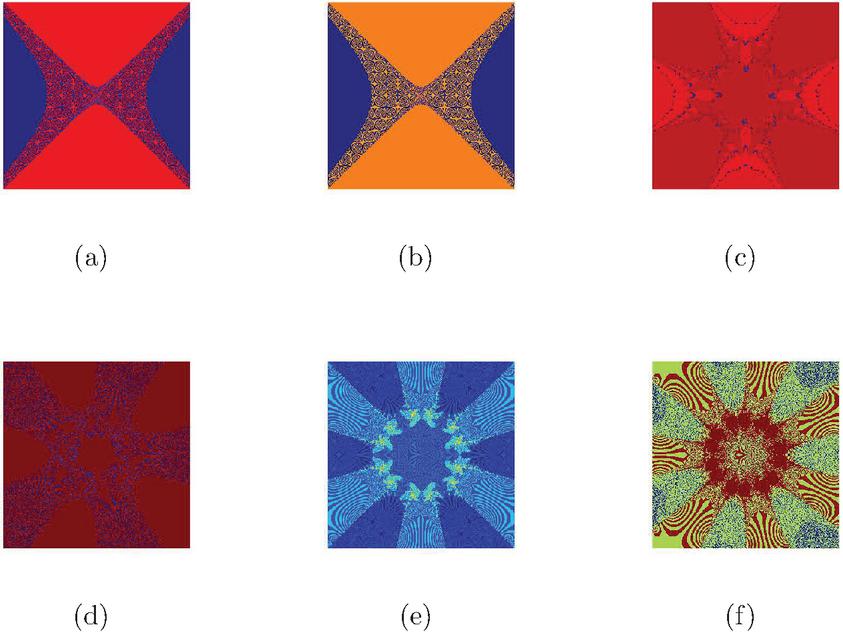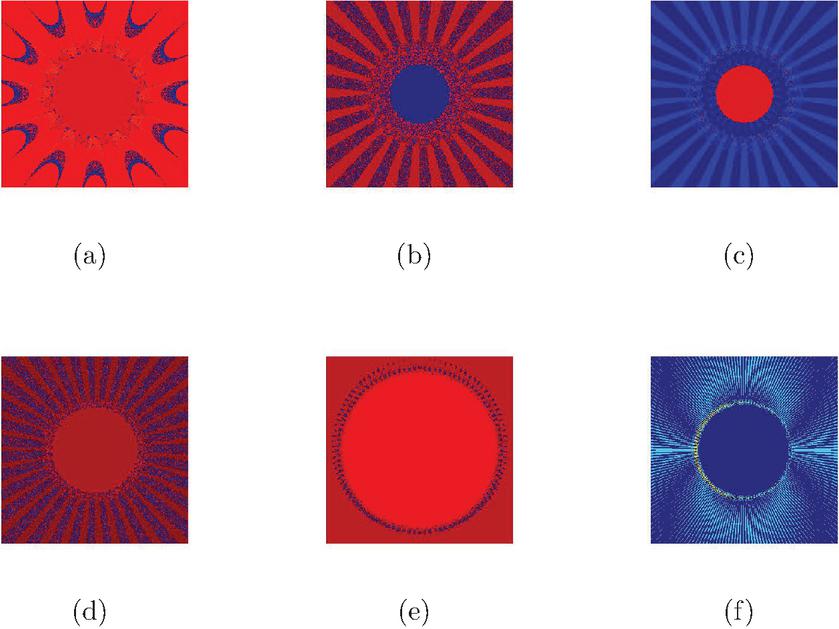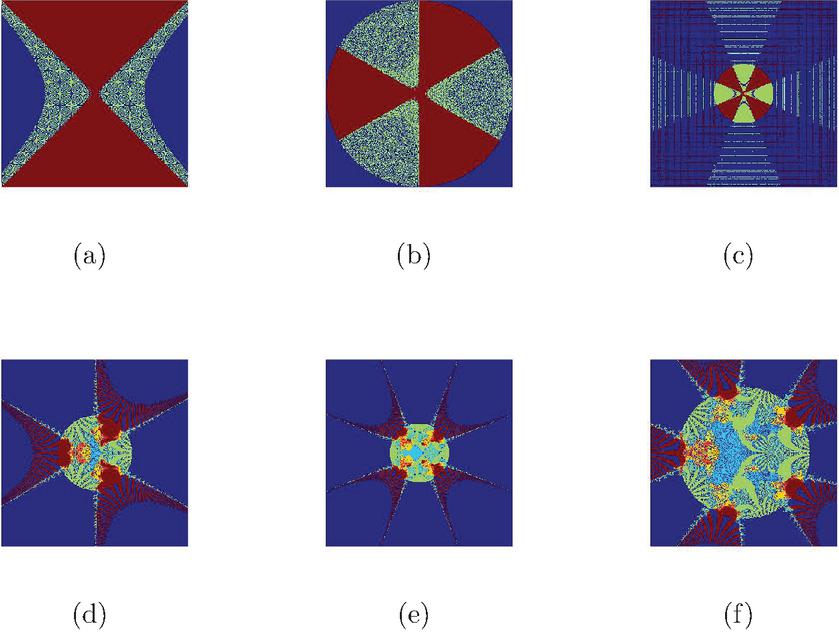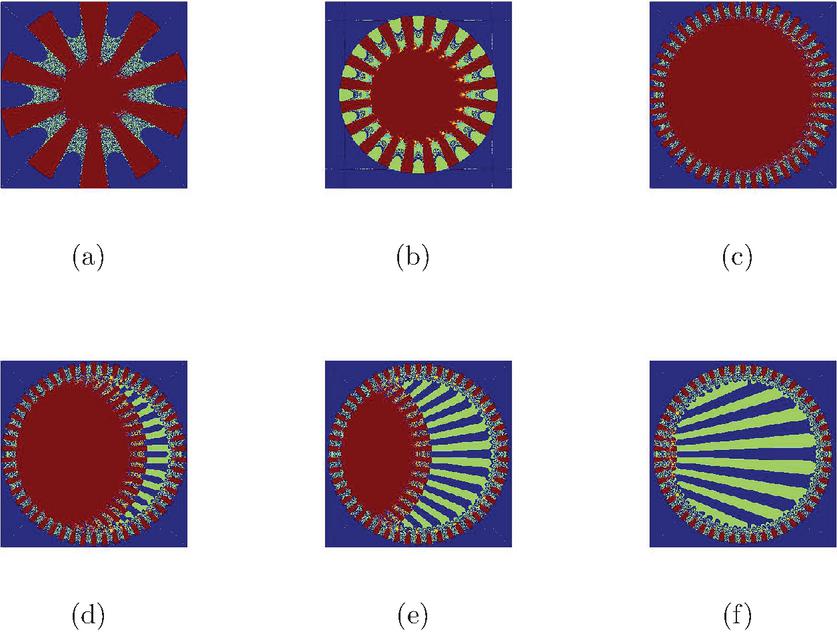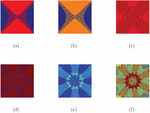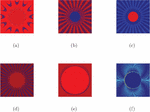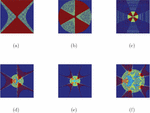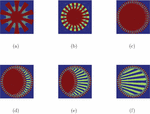Fractals as Julia and Mandelbrot Sets via S-iteration
Sanjay Kumar Padaliya*, 1, Saurabh Sharma1 and Jasvinder Pal Singh2
1S.G.R.R. (P.G.) College, Dehradun, 248001, Uttarakhand, India
2D.A.V. (P.G.) College, Dehradun, 248001, Uttarakhand, India
E-mail: spadaliya18@gmail.com; 75saurabhsharma@gmail.com; gogibindra@yahoo.co.in
*Corresponding Author
Received 12 March 2024; Accepted 15 May 2024
Abstract
To understand the phenomena of expanding symmetries Fractals patterns are an important tool which exhibit similar patterns for different scales. In the present paper, establishing an escape criteria by using S-iteration process to visualize fractals namely Julia and Mandelbrot sets for the function where and . The result obtain is a generalization of the existing algorithm and technique providing fractals for different parameter values. Also, the time taken to obtain fractals for different parameters by using computer software MATLAB is computed in seconds.
Keywords: Fractals, Julia set, mandelbrot set, escape criteria.
1 Introduction
Fractal patterns are form by replicating its shape at finer scales. To understanding natural or living phenomena like microorganisms fractals are an important tool [1]. Fractals are also commonly found in nature like crystals, rivers, branches of trees, coast lines, electricity, clouds and so on [2]. Radio signal and wavelength in wireless communication sector is an application of fractals [4]. Fractals are useful in fluid dynamics and mechanics to understand the behaviour of the streams. In addition, cryptography, encryption and image compression are also applications of the fractals [5]. The collection of points where complex valued functions shows chaotic behaviour is called Julia set and their collection is called Mandelbrot set. Similarity in a fractal at every point of is the same as the entire, for which any appropriate focussed part is more subdued when increased or decreased. In 1978 Benoit Mandelbrot used the term fractal [2], and from thereon he is known as the “father of fractal geometry”. For the generation of fractals, the role of the iterative scheme of fixed point theory is very important. Recently lots of authors used different iterative processes to generate the fractals for functions like sine,cosine,complex,exponential and so on [7]–[19].
In the present work, we use S-iterative process [20], to establish the escape criteria for visualizing fractals as Julia set and Mandelbrot set for function where and , we have given several examples to observe changes in graphical images and analyse the influence of underlying parameters on the dynamics, generation time, colour and shape variations of produced fractals. The coloured points within the resulting fractals represent “escape points,” meaning they approach infinity through the iteration method. The diverse colours indicate the rate at which a point escapes.
2 Preliminaries
We start with fundamental notions and definitions which are essential for this research.
The collection of points within a set of complex numbers so that the trajectory of the function ,diverging towards infinity, is termed as filled Julia set of .We can write
| (1) |
The Julia set of F is the boundary of .
The collection of parameters within a set of complex numbers so that the filled Julia set of F = +c is connected is termed as Mandelbrot set, Mathematically it is defined as :
.
The Mandelbrot set M encapsulates significant information related to the Julia set and can also be expressed as:
| (2) |
For , S-iteration is defined as
| (3) |
where , [0,1] and i = 0,1,2….
3 Main Results
To generate complex fractals escape criteria play an important role. We present the escape criterion for the function via S-iteration[ [20]]. S-iteration have two steps. The dependency on extends to all and within the complex number set . Specifically, for , in this article, we make the assumption that and .
3.1 Escape Criteria of S-iteration
Suppose where and be a function, then
| (4) |
where satisfying the bound ; , and similarly,
| (5) |
where satisfying the bound ; .
Let where p , c, a and be the S-iteration defined in with and . Then , as i .
Proof. Firstly we can consider
Then for i= 0 and from we get,
Next, by using (4), and the given fact , we have,
Next, in the second step of S-iteration,
.
for i=0 we have from (6), and ,
Following the same pattern, for i=1,
.
Next, for i=2, we have
Since and therefore, as .
For k if
,
then there exists a positive number so that
and then as .
4 Visualization of Fractals for the Function
To visualize the Julia sets we use Algorithm 1 and for Mandelbrot sets, Algorithm 2 , for obtaining fractals for logarithmic function using S-iteration scheme via MATLAB (R2015a) and colourmap (Figure 1). In this iterative process, numerous fractals emerge as Julia and Mandelbrot sets. It is noteworthy that many of these fractals exhibit symmetry. This resemblance proves advantageous in both the Textile Industry and interior decoration.
4.1 Julia Set
We visualize some Julia sets of function where and for different values of parameters using S-iteration. We have considered the maximum number of iterations are 50 (i.e., P=50).
Figure 1 Colourmap for the visualization of fractals.
Algorithm 1: For visualization of Julia Set
Input: where and ; , is area; P is maximum number of iterations;-parameter of S iteration. Colourmap [0..C-1]-colour with C colours.
Output: Julia set for area .
for do
R=Stoping threshold for S iteration
i=0
while do
if then
break
end if
i=i+1
colour with colourmap [i]
end for
Table 1 Parameter values for Figure 2
| Sr.No. | c | a | p | ||||
| (a) | 0.01i | 1 | 0.2 | 0.5 | 0.07 | 0.4 | 2 |
| (b) | 0.01i | 1 | 0.2 | 0.5 | 0.7 | 0.4 | 2 |
| (c) | 0.01 | i | 0.05 | 0.02 | 0.07 | 0.03 | 4 |
| (d) | 0.01 | i | 0.05 | 0.02 | 0.07 | 0.03 | 5 |
| (e) | 0.01 | 1 | 0.2 | 0.5 | 0.07 | 0.4 | 6 |
| (f) | 0.01 | 0.65 | 0.2 | 0.5 | 0.07 | 0.4 | 7 |
Figure 2 For the different values of c and p. (a) = [-50,50][-50,50] and time 2.287195 s. (b) =[-50,50][-50,50] and time 2.314692 s. (c) = [-2,2][-2,2] and time 2.412298 s. (d) = [-2,2][-2,2] and time 2.827401 s. (e) = [-2,2][-2,2] and time 2.790364 s. (f) = [-2,2][-2,2] and time 2.917099 s.(Where = Area).
We observe that Julia fractals appear like the traditional Kachhi Thread Works found in the Kutch district of Gujarat, India, and the number of outer bulbs is equal to the value of p. Surprisingly, the color for different values of p is different.(See Table 1 and Figure 2).
Table 2 Parameter values for Figure 3
| Sr.No. | c | a | p | ||||
| (a) | i | 1 | 0.02 | 0.05 | 0.07 | 0.04 | 12 |
| (b) | i | 1 | 0.02 | 0.05 | 0.07 | 0.04 | 25 |
| (c) | i | 1 | 0.02 | 0.05 | 0.07 | 0.04 | 30 |
| (d) | i | 1 | 0.02 | 0.05 | 0.07 | 0.04 | 35 |
| (e) | i | 1 | 0.02 | 0.05 | 0.07 | 0.04 | 100 |
| (f) | 1 | 1 | 0.02 | 0.05 | 0.07 | 0.04 | 200 |
Figure 3 For different values of p. (a) = [-2,2][-2,2] and time 2.942379 s. (b) = [-2,2][-2,2] and time 4.869238 s. (c) = [-2,2][-2,2] and time 5.935421 s. (d) = [-2,2][-2,2] and time 4.260984 s. (e) = [-1.2,1.2][-1.2,1.2] and time 5.107311 s. (f) = [-2,2][-2,2] and time 3.909764 s.
Higher order Julia set for fixed values of parameters is obtained. Julia fractals approach circular shapes as the value of p increases (See, Table 2 and Figure 3). These fractals share striking similarities with sunflower..
4.2 Mandelbrot set
Here we discuss several Mandelbrot sets for the function where and for different values of p in the trajectory of S-iteration. We have generated Mandelbrot sets for various parameters via S-iteration. For consistency across all fractals, we have set the maximum iteration to 50 (i.e., P=50) in Algorithm number 2.
Algorithm 2: For visualization of Mandelbrot Set
Input: where and ; ,-area; P-maximum number of iterations;-parameter of S iteration. Colourmap [0..C-1]-colour with C colours.
Output: Mandelbrot set for area .
for do
R=Stoping threshold for S iteration
i=0
while do
if then
break
end if
i=i+1
colour with colourmap [i]
end for
Table 3 Parameter values for Figure 4
| Sr.No. | a | p | ||||
| (a) | 0.1 | 0.2 | 0.5 | 0.1 | 0.3 | 2 |
| (b) | 0.1 | 0.2 | 0.5 | 0.1 | 0.3 | 3 |
| (c) | 1 | 0.02 | 0.05 | 0.01 | 0.03 | 4 |
| (d) | 2 | 0.2 | 0.5 | 0.5 | 0.9 | 3 |
| (e) | 2 | 0.2 | 0.5 | 0.5 | 0.9 | 4 |
| (f) | 2 | 0.2 | 0.5 | 0.5 | 0.9 | 5 |
Figure 4 For different values of p effects on the Mandelbrot set in S-iteration. (a) = [-50,50][-50,50] and time 3.973087 s. (b) = [-20,20][-20,20] and time 3.978889 s. (c) = [-50,50][-50,50] and time 4.547364 s. (d) = [-5,5][-5,5] and time 4.086939 s. (e) = [-5,5][-5,5] and time 4.732100 s. (f) = [-2,2][-2,2] and time 4.930074 s.
Mandelbrot fractals appear as in Figure 4, and the number of outer bulbs is equal to the numerical values of p for entries in Table 3.
Table 4 Table 4: Parameter values for Figure 5
| Sr.No. | a | p | ||||
| (a) | 0.1 | 0.001 | 0.009 | 0.1 | 0.9 | 10 |
| (b) | 0.1 | 0.001 | 0.009 | 0.1 | 0.9 | 20 |
| (c) | 0.1 | 0.001 | 0.009 | 0.1 | 0.9 | 50 |
| (d) | 0.5 | 0.001 | 0.009 | 0.1 | 0.9 | 50 |
| (e) | 1 | 0.001 | 0.009 | 0.1 | 0.9 | 50 |
| (f) | 2 | 0.001 | 0.009 | 0.1 | 0.9 | 50 |
Figure 5 For different values of a and p effect on Mandelbrot set in S-iteration. (a) = [-3,3][-3,3] and time 4.467746 s. (b) = [-2,2][-2,2] and time 4.548568 s. (c) = [-1.2,1.2][-1.2,1.2] and time 5.420616 s.(d) = [-1.2,1.2][-1.2,1.2] and time 5.795210 s. (e) = [-1.2,1.2][-1.2,1.2] and time 5.967584 s. (f) = [-1.2,1.2][-1.2,1.2] and time 6.157547 s.
Higher order Mandelbrot set is obtained. As the value of p increases, Mandelbrot fractals approach circular shapes. Refer to Figure 5 and Table 4 for details. As value of a increase the changes in fractal shape can be seen in Figure 5(d)–5(f).
5 Conclusions
The escape criteria for the function , where and , have been shown using S-iteration. By applying the outcomes of Algorithms 1 and 2 in S-orbit, the Julia and Mandelbrot sets have been visualised. With thorough explanations, we have talked about the created Julia sets and Mandelbrot sets for various values. We also noticed that the number of repellers and attractor is different for different values of p. The fractals also get more colourful for complex values of c, and the mandelbrot set starts to take on a circular shape for higher values of p. Additionally, we computed the execution time in seconds for the fractal generation, demonstrating that the execution time varies for various parameters in the generations of fractals as defined by the Julia and Mandelbrot sets. We have looked at many approaches to creating images and assessed how parameters affect the dynamics, colour, and general look of fractals. Some of the fractals in our collection have an amazing resemblance to the traditional Kachhi Thread Works from Gujarat’s Kutch district and to Rangoli patterns created throughout India. There are several benefits to this similarity for the interior design and textile industries. Furthermore, some of the fractals in our collection exhibit a remarkable similarity to the spinning wheel that is traditionally used on Diwali. These results can be applied to determine the usage of various iterative methods in fractal formation.
References
[1] Weibel, E. R. (1991). Fractal geometry: a design principle for living organisms. American Journal of Physiology-Lung Cellular and Molecular Physiology, 261(6), L361–L369.\hrefhttps:/doi.org/10.1152/ajplung.1991.261.6.L361 [CrossRef]
[2] Mandelbrot, Benoit B., and Benoit B. Mandelbrot. The fractal geometry of nature. Vol. 1. New York: WH freeman, 1982.
[3] Barcellos, Anthony. “Fractals Everywhere. By Michael Barnsley.” The American Mathematical Monthly 97.3 (1990): 266-268.\hrefhttps:/doi.org/10.1080/00029890.1990.11995589 [CrossRef]
[4] Cohen, N. (1997, May). Fractal antenna applications in wireless telecommunications. In Professional Program Proceedings. Electronic Industries Forum of New England (pp. 43–49). IEEE.
[5] Madaan, A., Bhatia, M.,and Hooda, M. (2018). Implementation of image compression and cryptography on fractal images. In Advances in Data and Information Sciences: Proceedings of ICDIS-2017, Volume 1 (pp. 49–61). Springer Singapore.\hrefhttps:/doi.org/10.1007/978-981-10-8360-0_5 [CrossRef]
[6] Abbas, M., and Nazir, T. (2014). Some new faster iteration process applied to constrained minimization and feasibility problems.\hrefhttp:/hdl.handle.net/2263/39674 [CrossRef]
[7] Tomar, A. N. I. T. A., et al. “Mandelbrot fractals using fixed-point technique of sine function.” Proc. Inst. Math. Mech. Natl. Acad. Sci. Azerb. Vol. 48. 2022.\hrefhttps:/doi.org/10.30546/2409-4994.48.2022.194214 [CrossRef]
[8] Abbas, M., Iqbal, H., and De la Sen, M. (2020). Generation of Julia and Mandelbrot sets via fixed points. Symmetry, 12(1), 86.\hrefhttps:/doi.org/10.3390/sym12010086 [CrossRef]
[9] Husain, A., Nanda, M. N., Chowdary, M. S., and Sajid, M. (2022). Fractals: an eclectic survey, part-I. Fractal and Fractional, 6(2), 89.\hrefhttps:/doi.org/10.3390/fractalfract6020089 [CrossRef]
[10] Prajapati, D. J., Rawat, S., Tomar, A., Sajid, M., and Dimri, R. C. (2022). A brief study on Julia sets in the dynamics of entire transcendental function using Mann iterative scheme. Fractal and Fractional, 6(7), 397.\hrefhttps:/doi.org/10.3390/fractalfract6070397 [CrossRef]
[11] Shatanawi, W., Bataihah, A., and Tallafha, A. (2020). Four-step iteration scheme to approximate fixed point for weak contractions. Comput. Mater. Contin, 64, 1491–1504.
[12] Shahid, A. A., Nazeer, W., and Gdawiec, K. (2021). The Picard-Mann iteration with s-convexity in the generation of Mandelbrot and Julia sets. Monatsh Math, 195, 565–584.\hrefhttps:/doi.org/10.1007/s00605-021-01591-z [CrossRef]
[13] Antal, S., Tomar, A., Prajapati, D. J., and Sajid, M. (2021). Fractals as Julia sets of complex sine function via fixed point iterations. Fractal and Fractional, 5(4), 272.\hrefhttps:/doi.org/10.3390/fractalfract5040272 [CrossRef]
[14] Qi, H., Tanveer, M., Nazeer, W., and Chu, Y. (2020). Fixed point results for fractal generation of complex polynomials involving sine function via non-standard iterations. IEEE Access, 8, 154301–154317.
[15] Cho, S. Y., Shahid, A. A., Nazeer, W., and Kang, S. M. (2016). Fixed point results for fractal generation in Noor orbit and s-convexity. SpringerPlus, 5, 1-16.\hrefhttps:/doi.org/10.1186/s40064-016-3530-5 [CrossRef]
[16] Tassaddiq, A., Tanveer, M., Azhar, M., Arshad, M., and Lakhani, F. (2023). Escape Criteria for Generating Fractals of Complex Functions Using DK-Iterative Scheme. Fractal and Fractional, 7(1), 76.\hrefhttps:/doi.org/10.3390/fractalfract7010076 [CrossRef]
[17] Tomar, Anita, et al. “Fractals as Julia and Mandelbrot Sets of Complex Cosine Functions via Fixed Point Iterations.” Symmetry15.2 (2023): 478.\hrefhttps:/doi.org/10.3390/sym15020478 [CrossRef]
[18] Shahid, A.A., Nazeer, W. and Gdawiec, K. The Picard–Mann iteration with s-convexity in the generation of Mandelbrot and Julia sets. Monatsh Math 195, 565–584 (2021).\hrefhttps:/doi.org/10.1007/s00605-021-01591-z [CrossRef]
[19] Özgür, Nihal, Swati Antal, and Anita Tomar. “Julia and Mandelbrot sets of transcendental function via Fibonacci-Mann iteration.” Journal of Function Spaces 2022 (2022).\hrefhttps:/doi.org/10.1155/2022/2592573 [CrossRef]
[20] Agarwal, R. P., O Regan, D., and Sahu, D. (2007). Iterative construction of fixed points of nearly asymptotically nonexpansive mappings. Journal of Nonlinear and convex Analysis, 8(1), 61.
[21] Julia, G. (1918). Mémoire sur l’itération des fonctions rationnelles. Journal de mathématiques pures et appliquées, 1, 47–245.
[22] Devaney, R. L. (2018). A first course in chaotic dynamical systems: theory and experiment. CRC Press.
[23] Mandelbrot, B. B., and Mandelbrot, B. B. (1982). The fractal geometry of nature (Vol. 1). New York: WH freeman.
[24] Noor, M. A. (2000). New approximation schemes for general variational inequalities. Journal of Mathematical Analysis and applications, 251(1), 217-229.\hrefhttps:/doi.org/10.1006/jmaa.2000.7042 [CrossRef]
Biographies

Sanjay Kumar Padaliya is presently, Head, Department of Mathematics, S.G.R.R. (P.G) College, Dehradun. He received his Ph.D. degree in Mathematics (fixed point theory and fuzzy analysis) from Kumaun University, Nainital. He has been teaching basic courses in Mathematics at graduate and postgraduate level for the last 24 years. His present research interest includes the fixed point theory, Fuzzy Analysis and Fractal Geometry. He has published/accepted over 30 scientific papers in various international journals of repute and also presented his works at national and international conferences. Dr. Padaliya supervised 05 research scholars and 03 being supervised for Ph.D. He was also the IQAC/NAAC Co-ordinator of the college from the year 2016 to 2022 in which the college obtained the highest grade. He is member of BoG in Dev Bhoomi Uttarakhand University, Dehradun and Associate Editor of Journal of Graphic Era University and he is also a life member of Indian Mathematical Society, Ramanujan Mathematical Society and International Academy of Physical Sciences.

Saurabh Sharma is currently a Ph.D. research scholar in the Department of Mathematics at S.G.R.R. (P.G.) College, Dehradun, under the supervision of Dr. Sanjay Kumar Padaliya. He completed his M.Sc. from D.A.V. (P.G.) College, Dehradun, in 2017. In 2022, he qualified the Joint CSIR-UGC NET. His present research interests include the application of fixed point theory and fractal geometry. He has published/accepted one scientific paper and has presented his work at both national and international conferences.

Jasvinder Pal Singh is presently working as Assistant professor in D.A.V. (P.G.) College, Dehradun. He received his Ph.D. degree in Statistics from C.C.S. University Meerut. He has been teaching in undergraduate level and postgraduate level for the last 15 years.
Journal of Graphic Era University, Vol. 12_2, 207–222.
doi: 10.13052/jgeu0975-1416.1222
© 2024 River Publishers

